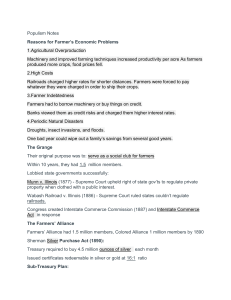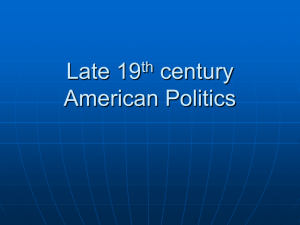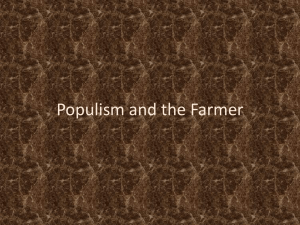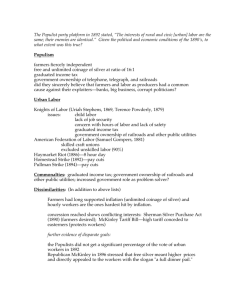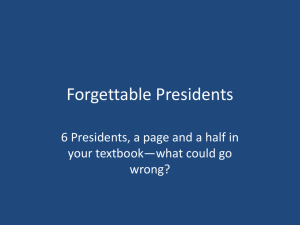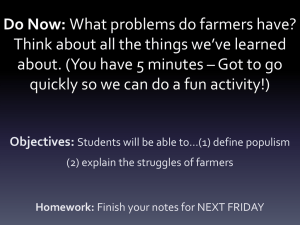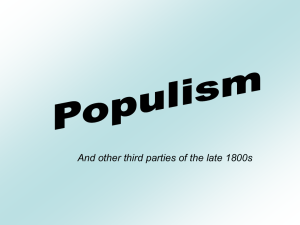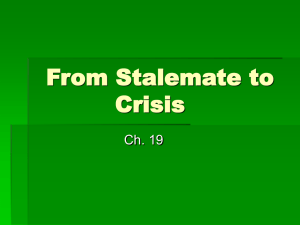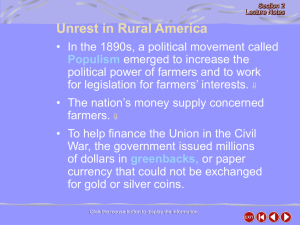Agrarian Revolt
advertisement
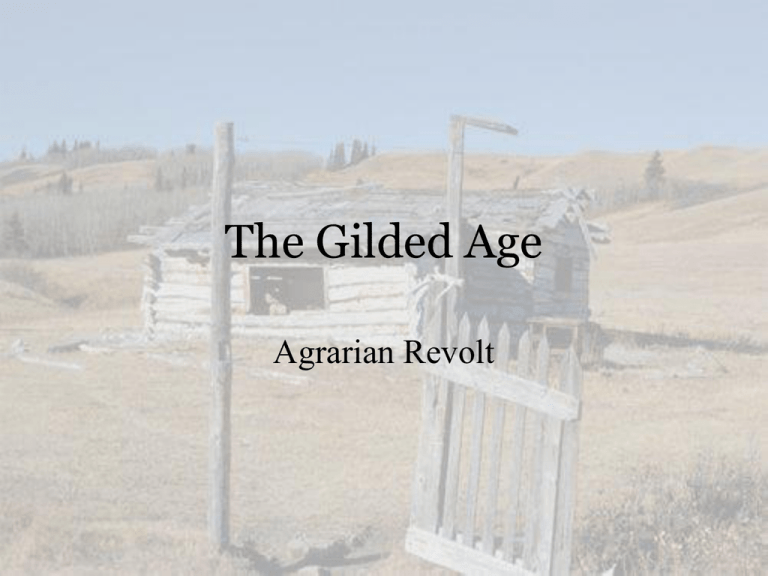
The Gilded Age Agrarian Revolt Causes of Farm Decline Natural Factors: Drought Fire Blizzards Insects Erosion Market Factors: Falling commodity prices High debt levels High transportation costs High storage fees The Impending Farm Crisis Falling commodity prices Long term drop in commodity prices from 1870-1898 Two main causes Domestic overproduction New technologies, improved crops As prices fell, farmers had to grow more to earn same amount of money Excess production drove prices even lower Foreign competition Growing transportation network tied farmers into national and international markets The Impending Farm Crisis High debt levels Farm land rose in value thru the mid-1870s Investors launched mortgage companies to finance expansion In KS, NB, MN, DK, at least one mortgage per family Mortgage debt in KS tripled between 1880-1887 The Impending Farm Crisis High transportation and storage fees Railroads primary target Discriminatory rates Grain elevators were second target Had a monopoly on buying grain Farmers had to sell or pay fees for use National Politics Both the Democratic and Republican parties were equally beholden to special interests. Neither party could gain control of the government. Republicans dominated the presidency Democrats, on the other hand, controlled Congress and most state legislatures Each party struggled to find political issues to distinguish it from the other and to try to seize government power National Politics Republicans From 1868 to 1880, the most common Republican campaign tactic was to wave the "Bloody Shirt" Reminded voters of the South's dishonor of seceding and causing the Civil War. This tactic painted all Democrats as traitors to the Union. National Politics Democrats Reducing influence of federal government Cutting expenses States’ rights Organizational Challenges for Farmers Rugged individualism Physical isolation Conflicting interests The Grange Midwest National Grange formed as a social/educational club in 1867 Became a forum for political debate in 1870s Became a potent political force by mid-1870s Goal was to regulate freight rates, elevator fees Hoped to free farmers from traditional market 1875-1884 ran candidates under “Greenback” Party 1,000,000 votes in 1878 elections Went into decline in 1880s Unable to achieve goals Farmers’ Alliance South and Midwest Offered social and recreational activities Sense of community a strong attraction Stressed political action Wanted to set up exchanges (Coops) Failed due to business, banker opposition Sub-treasury plan Formed Colored Alliance in 1886 Stressed economic, not social equality Unable to achieve its goals alone, the Farmer’s Alliance sought allies to increase its power The Sub-Treasury Plan Farmer’s would be able to: Store crops in government warehouses Obtain government loans Up to 80% of crop’s value 1% interest on loan Hoped it would spark inflation and raise crop prices. The Populist Party The People’s Party Founded in 1892 Composed of Farmer’s Alliance Colored Alliance The Grange (remnants) The Knights of Labor The Greenback Party (remnants) Very successful at state level in the Midwest Presidential Campaign - 1892 The Populist Platform Financial Goals: Free coinage of silver (@16/1) Graduated income tax Increased money supply Sub-Treasury plan Presidential Campaign - 1892 The Populist Platform Transportation Goals Government ownership of: Railroads Telegraph Telephones Presidential Campaign - 1892 The Populist Platform Labor and Social Goals: Land reform Immigration restriction 8 hour workday End of injunctions against labor Restrictions on strike breakers Election of 1896 Dominant Issue: Sound Money Republicans William McKinley Gold Standard, High Tariffs (Hard Money) Democrats William Jennings Bryan Free Silver, Low Tariffs (Soft Money) Populists William Jennings Bryan Free Silver (Soft Money) William Jennings Bryan: “I don’t know anything about free silver. Nebraska is for free silver, therefore I am for free silver. I will look up the details later.”
